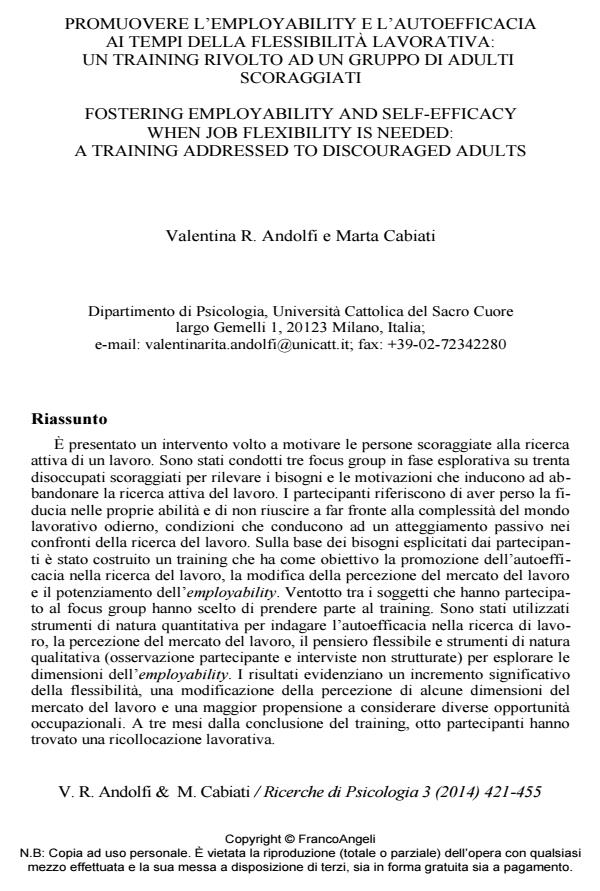Fostering employability and self-efficacy when job flexibility is needed: a training addressed to discouraged adults
Journal title RICERCHE DI PSICOLOGIA
Author/s Valentina R. Andolfi, Marta Cabiati
Publishing Year 2015 Issue 2014/3
Language Italian Pages 35 P. 421-455 File size 294 KB
DOI 10.3280/RIP2014-003003
DOI is like a bar code for intellectual property: to have more infomation
click here
Below, you can see the article first page
If you want to buy this article in PDF format, you can do it, following the instructions to buy download credits

FrancoAngeli is member of Publishers International Linking Association, Inc (PILA), a not-for-profit association which run the CrossRef service enabling links to and from online scholarly content.
An intervention aimed at motivating discouraged people to actively look for a job is reported. Three focus groups on thirty unemployed discouraged adults allowed investigators to identify the reasons which lead people to abandon the search for a job: they lose confidence in their own abilities and they are not able to cope with the complexity of the labor market, conditions that lead to a passive attitude toward job search. Hence, the training which was devised, aimed at promoting self-efficacy in job search, modifying the perception of the labor market and strengthening employability. Twenty-eight of those people who were involved in the focus groups participated in the training. Questionnaires were administered to investigate self-efficacy in job search, perception of the labor market and flexible thinking. Observation and interviews explored the employability dimensions. Results showed a significant increase of flexibility, a change in the perception of some dimensions of the labor market and a higher propensity to consider other employment opportunities. Three months after the training eight participants found a job relocation.
Keywords: Employability, Discouragement, Unemployment, Job search, Selfefficacy, Flexibility.
- Potenziare la flessibilità cognitiva in età anziana: gli effetti di un training Sabrina Rago, Valentina Rita Andolfi, Alessandro Antonietti, Giuseppe Iannoccari, Nicoletta Porcu, Chiara Valenti, in RICERCHE DI PSICOLOGIA 2/2020 pp.691
DOI: 10.3280/RIP2020-002011
Valentina R. Andolfi, Marta Cabiati, Promuovere l’employability e l’autoefficacia ai tempi della flessibilita lavorativa: un training rivolto ad un gruppo di adulti scoraggiati in "RICERCHE DI PSICOLOGIA " 3/2014, pp 421-455, DOI: 10.3280/RIP2014-003003